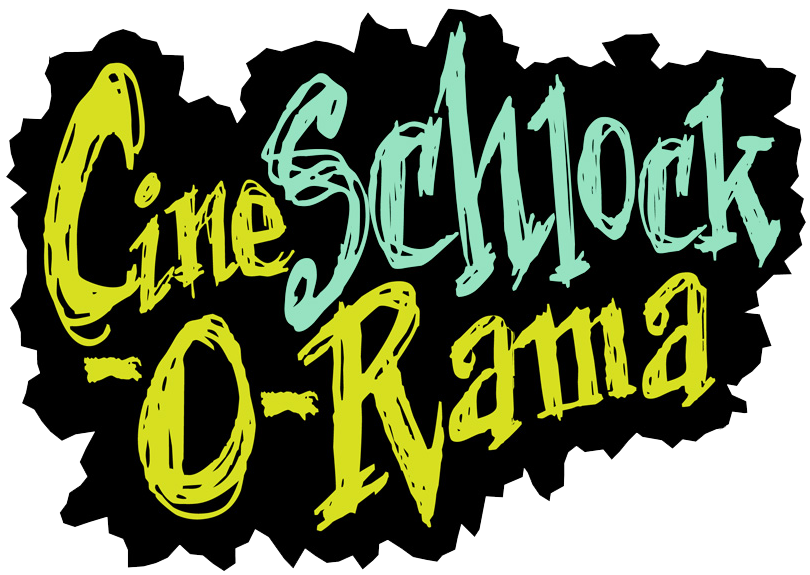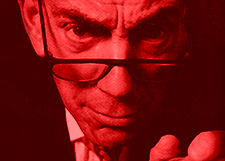
The Godfather of Gore
April 27, 2001
Part of what makes Herschell Gordon Lewis so fascinating is that he’s really two people. Fans and detractors alike describe him as The Godfather of Gore due to his gruesome exploits as a ’60s drive-in titan. While, to the button-down business world he’s a direct-marketing guru and all-around good egg. Certainly no ghoul. That is, of course, unless one happens to catch that wicked gleam in his eye — the one that reveals his gloriously grim sense of humor.
It was my great fortune to interview one of my foremost B-idols about his growing DVD catalog. Mr. Lewis shares, in great detail, his fledgling steps into sexpolitation success with The Adventures of Lucky Pierre. He reveals how he and partner David F. Friedman expertly marketed ground-breaking films like Blood Feast and Two Thousand Maniacs. We also learn when Lewis first realized the cult status both he and his films had achieved. Plus, Herschell clubs me over the head with the biggest news of all — his return to filmmaking after 28 years — with Blood Feast 2: Buffet of Blood!!!
They’ve done a great job with your DVDs at Something Weird, but you put in quite a few hours on them yourself, with the commentary tracks. Can you tell me a little bit about that process?
I’ll bet. They’re certainly a lot of fun to listen to, and they sound like that. You really do sound as though you’re enjoying yourself, and I’m surprised with the amount of details that you can share after all these years.
"Auteur" is sort of a dirty word with you, almost.
No! That’s exactly the sort of stuff I’d like to hear. You’ve told the story many times, of actually going in to meet David Friedman the first time, but how did you become aware of him?
When Joseph’s company eventually went out of business, it was a very sad thing for us both, because he owed my company for a lot of film rentals. Dave was also at loose ends. Now, I had a benefit in that I was knowledgeable in the area of film directing: use of a camera, how to cut film, and so on. Especially in 35mm. So, I got a job as a director at the old United Film and Recording Studio on Erie Street in Chicago, which wasn’t all that good, but at least I was able to put Kraft dinner on the table.
Dave’s background was primarily in publicity and the release and distribution of movies. So, he went out hunting distribution deals. Dave was able to negotiate some sort of relationship with a distributor in Dallas, Texas — a superannuated, crotchety old guy named Al Sack. He was the Irwin Joseph of Dallas. Both Sack and Joseph were anomalies in film distribution: They were honest people. [Laughs.]
Dave said, "I’ve got a deal here if you want it. Al tells me, if we can make a one-reel, color 35mm film of cute girls carousing around with beach balls, or whatever, he will pay us $7,000." An egregious fortune in those days. I looked in my little crystal ball for about two seconds, and said, "Wait a minute! I can use the camera here at United Film Studios." They had one that was so old it belonged in the Smithsonian. But it worked. It was a 35mm Mitchell camera. I said, "OK, I can be on the camera, and I can cut this film. Our only cost will be a couple of models and some raw stock." I figured we could come out of there with perhaps $2,000 each, which was a lot of money, especially in the condition the two of us were in. I said, "Dave, you tell him he’s got himself a deal!"
In ancient Greek drama, there’s a device they call the deus ex machina — god from machine — and when the Greek dramatist couldn’t figure a way out of a plot line, they would have a god come down on the stage in a basket. [Laughs.] He would wave his arms and that would resolve the plot line. I had a deus ex machina. A fella named Jack Curtain — I guess my Alzheimers is in remission, because I remember these names — and Jack Curtain worked for a New York film laboratory. He came in to see me and said, "What are you working on?" Well, everybody has to show off, and so I go, "Oh, I’ve got this deal with Al Sack." And I told him the story and he said, "This kind of thing is a hot property right now. If you will expand this from one reel to a full-length movie of 70 minutes, I will give you this proposition: No laboratory bills will be due until 90 days after the answer print is delivered." Now in English, that means I can get a finished print, put it in the theaters, and have the film rentals pay off the lab. And instead of Al Sack owning this movie, we would own it. That was really a no brainer.
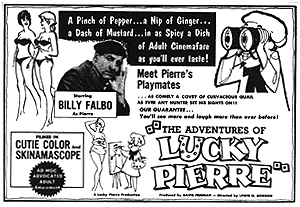
It was October, it was cold in Chicago, and that’s when we shot The Adventures of Lucky Pierre. We shot it in four days. When the sun was out, we shot. Sometimes it was in the 50s, which was not good for the girls. We had a knock-down comedian named Billy Falbo who had a little part in a movie I made called Living Venus. Falbo was delighted to be in this thing, because it gave him a chance to mug at the camera. I was the producer, director and camera man. Dave was the producer and sound man. We were the crew. The actors had to handle their own clap stick, throw it aside and start acting. [Laughs.] In fact, we made up titles, we had "Lenses by Coca-Cola Bottling Company." Just to make sure the whole thing was accepted as a total satire, which it was.
People like Russ Meyer were making films something like this. But they were shooting 16mm and blowing it up. Lucky Pierre was the first one shot in actual 35mm color and shot on a Mitchell camera, then the Rolls Royce of cameras. So, when people would go to a drive-in theater, here was this beautiful, rock-hard image on the screen, which belies the cheapness of this movie. [Laughs.]
Seventy minutes is 6,300 feet of 35mm film. We only bought 8,000 feet of film, so when we cut the slates off, there was nothing left! We didn’t have enough to make a trailer, but it made no difference at all. There was a fella in Chicago named Tom Dowd who ran a little theater called The Capri. Tom Dowd was a friend of Dave Friedman. Dave did, and does, know everybody in the business. He is the most fantastic contact man I have ever met. There is nobody on this planet that doesn’t know Dave Friedman. Anyway, Tom Dowd agreed to play Lucky Pierre in his theater, and we gave him the answer print. The technical aspect of filmmaking wasn’t as grand as it is now. The answer print was the one you used to make corrections, so there were things that were dark and things that were light, but it was inconsequential. He played that thing for nine weeks and it far, far more than covered the entire cost of everything we had done. [Laughs.] And I said, "How long has this been going on?" That, of course, was the renaissance of my filmmaking career.
I know the more popular answer would be Blood Feast, but my favorite of your pictures is Two Thousand Maniacs. I guess it must be the Southerner in me.
Is it!? OK, good. What about it are you so connected to?
And boy did it!
Can we talk a little bit about the marketing of your films? Did you write the copy for the posters?
I like the little asides on some of the posters. The warnings. The "admonition" on the Blood Feast poster. Do you remember how that came about?
If you ever saw the trailer — the "coming atrocity" — for Blood Feast, there was a fella standing there with a red background. "Ladies and gentlemen, you are about to see scenes from the most unusual picture of all time. We urgently recommend if you have a heart condition, or if you are with a young and impressionable child, that you leave this auditorium." Figuring that if that wouldn’t keep them in there, nothing would. It was a disclaimer, and disclaimers always have an effect opposite of the one that’s intended. [Laughs.] But sometimes we would get heat, because the immediate thing that came on after, before people could even move an inch out of their seat, was the tongue scene. Occasionally, that would be the coming attraction while they had a Disney movie playing, so we’d get screamed at.
That was the curse of the bold, hearty pioneer. Now, of course, it makes no difference at all. Then, we were breaking ground that was considered strange. Before the ratings system, many censor boards existed in individual towns and states. There was censorship against nudity. We didn’t have any nudity in Blood Feast. There was censorship against obscenity. We had no obscenity. There was nothing mentioned about blood gushing, because no one had ever done it. So, we initiated a lot of regulation that hadn’t existed before. [Laughs.]
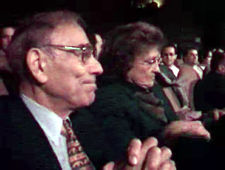 When did you first become aware of the cult status your films had achieved?
When did you first become aware of the cult status your films had achieved?
I was writing articles for various magazines for the industry that I’m now in, which is direct marketing. He said, "I found your name, and there can’t be two people named Herschell Gordon Lewis, so I took a chance that you were the same one." I said, "Yeah, I’m the same one." He said, "May I invite you to New York. We’ll pay you and your wife’s airfare." I said, "Come on, give me your phone number and I’ll call you back." He gave me a number that ended in three zeros, with a four digit extension. I called the number and it was Exxon Corporation, and I said, "Oh yeah, I know the gag." I gave them the extension and they said, "Mr. Sullivan’s office." I said, "Can you tell me what his position is?" He was an accountant. It turns out this is typical of the new age of gorehounds. By day, he had a legitimate job. At night, his fangs came out. [Laughs.]
I figured, "OK, I’ll go to New York." I said to my wife, "Margo, be prepared for this to be one of these Harvard Lampoon kind of things. It’s ridicule, but it’s good-natured ridicule." They met the plane. I figured the adulation was certainly fake. We get to this theater, and I’d never seen anything like it. It was like an Adolf Hitler rally. They showed a print of The Wizard of Gore, which was in such bad shape, it look like it was soaked in beer. Scratched all over the place. I thought, "Oh, god." Then I got up to speak and said, "Good evening." And this wild applause erupted. And I thought, "Gee, I’ve got even more profound things to say." That began the renaissance.
About what year was that?
Over the last 25 years I’ve heard, "Let’s make Blood Feast 2," which is just conversation for a lot of people. Now, apparently, some people who are seriously in the film business do intend to make Blood Feast 2, and I’m supposed to direct it. Which I surely will do if it materializes. The guy insists it’s going to be the end of July. His name is Jacky Morgan, and he’s a film producer who knows what he’s doing. The difference between Jacky Morgan and everybody that’s come before him is two fold. First, he has a script. It’s not the script that I would have written, but he has invested in a full-length professional script. Second, he’s already sent me a shot breakdown, which normally the director does. This is not just, "Let’s make a movie!" He is seriously interested in this. His shot breakdown makes a great deal of sense. He has an 18 or 20 day shooting schedule, and I’m half inclined to believe this really will materialize. [Details below.]
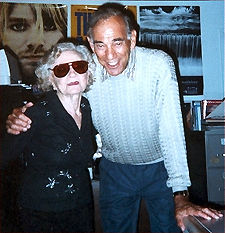 Wow! I would desperately like that to happen. That would be great! At these festivals, you kind of reconnect with some of the people from your past. I understand you actually met Doris Wishman for the first time.
Wow! I would desperately like that to happen. That would be great! At these festivals, you kind of reconnect with some of the people from your past. I understand you actually met Doris Wishman for the first time.
The DVD culture includes a lot of film purists. They’re all interested in widescreen and that sort of thing. What were the original ratios of your films?
Mr. Lewis, this has just been a big thrill for me, and I really appreciate your time. Is there anything you’d like to say to your fans out there?
